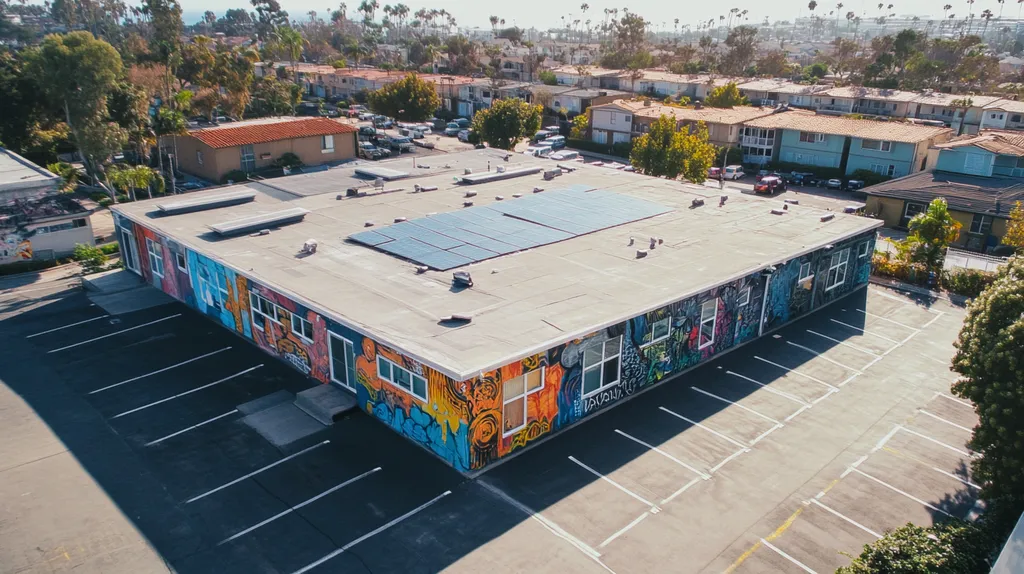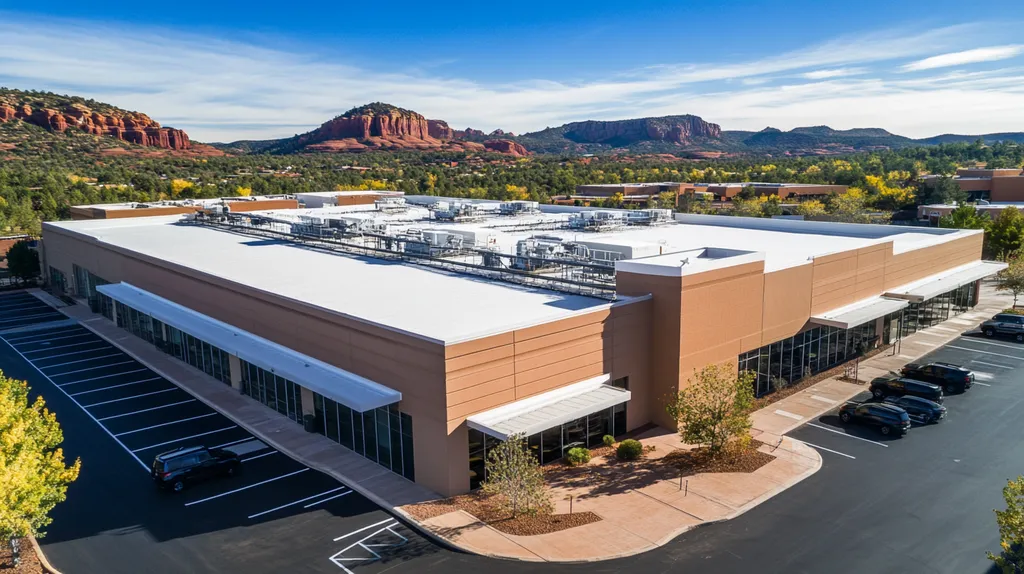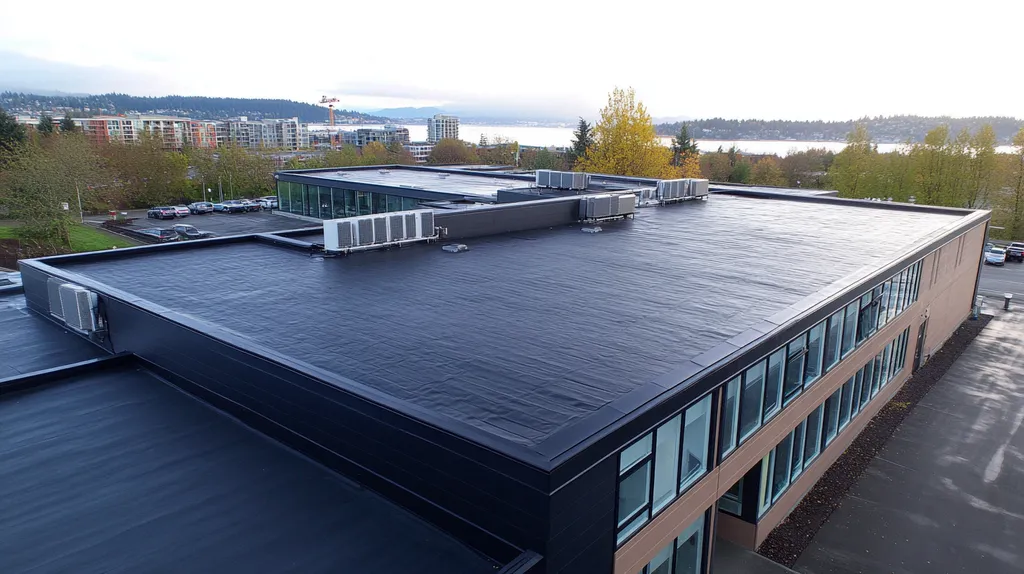In industrial roofing projects, the cost of poor communication can be staggering—studies show miscommunication leads to an average 25% increase in project expenses and dangerous safety oversights.
From material specifications to installation timelines, clear communication serves as the foundation for successful roofing projects that protect valuable assets and operations.
This comprehensive guide examines the essential elements of effective communication in industrial roofing, providing property owners and facility managers with practical strategies to ensure project success.
SECTION 1: THE BASICS EXPLAINED
In the realm of industrial roofing, the stakes are high—effective communication can be the deciding factor that ensures a project finishes on time and within budget. When plans are poorly communicated, it can lead to delays, unexpected costs, and safety hazards. Research shows that lapses in communication can inflate project expenses by as much as 25%. Understanding the essentials of effective communication in roofing projects is crucial for protecting investments and keeping operations running smoothly.
What It Is (In Plain Language)
Clear communication in industrial roofing projects is about effectively sharing information among all involved parties, including property owners, facility managers, contractors, and suppliers. Everyone needs to understand the project goals, timelines, and materials to work toward a common objective.
This is achieved through regular discussions, straightforward language, and clarity in roles and responsibilities. When everyone is informed, the chances of errors drop significantly.
For instance, if a roofing contractor has a pressing need for certain materials, clear communication will ensure that the supplier acknowledges the urgency. Without this dialogue, material delays can derail the entire project.
In essence, communication goes beyond merely exchanging information; it serves as a strategic tool that drives project success.
Why It Matters (To Your Building)
The importance of good communication in roofing projects extends to the building’s overall wellbeing. When stakeholders communicate effectively, decision-making becomes sharper, and problems can be addressed proactively.
A miscommunication surrounding building specifications, for example, could lead to a roofing solution that is not suitable for the structure. If a contractor misunderstands the drainage requirements, it might cause water to pool, leading to prominent structural damage—issues that clear communication could easily prevent.
Moreover, strong communication keeps everyone updated on progress and potential challenges. Frequent updates minimize surprises, allowing property managers to navigate operational changes smoothly.
Ultimately, prioritizing clear communication not only enhances the roofing project but also safeguards the entire facility’s integrity.
How It Works
Effective communication during industrial roofing projects thrives on established protocols and consistent documentation. The initial project meeting sets the groundwork by clarifying expectations and outlining milestones.
Project management tools can streamline communication by providing a unified platform for access to updates, documents, and schedules. This clarity reduces the risk of information getting lost or misinterpreted.
Regular check-ins should be built into the schedule to monitor progress and address concerns. This proactive approach allows for quick resolution of issues, rather than waiting until the project’s conclusion.
In conclusion, by embracing systematic communication strategies, all parties can ensure alignment on project goals. This unity is crucial for achieving a successful roofing project while maintaining the integrity of the building.
SECTION 2: PRACTICAL APPLICATIONS
Clear communication is the backbone of successful industrial roofing projects. Without it, the risk of costly mistakes, safety hazards, and structural failures increases dramatically. For instance, if there’s a misunderstanding about material specifications, it could result in the use of unsuitable roofing materials, putting the entire project at risk. This section delves into how effective communication can be applied in different areas, the critical moments when it is most necessary, and how it interacts with other building systems.
Common Uses & Examples
Effective communication plays a crucial role at every stage of an industrial roofing project, from the initial planning phase to the final execution. One key area is during the initial consultations, where property owners share their needs and expectations. A well-structured dialogue ensures that all parties clearly understand specific requirements, significantly reducing the chances of errors down the line.
Documentation also plays a pivotal role in effective communication. Detailed project proposals and contracts serve as concrete reference points, reducing ambiguity. For example, a comprehensive description of material types and installation methods can prevent disputes and set clear expectations for all involved.
Safety protocols during installation are another crucial aspect of communication. Quick and clear instructions regarding safety measures are essential for protecting workers and property alike. Daily safety briefings can reinforce these protocols and keep everyone on the same page as the project unfolds.
Furthermore, strong communication practices extend to post-project discussions about maintenance. Providing facility managers with clear guidelines and schedules ensures they understand how to care for the roofing system, thus maximizing the longevity of their investment.
When You Need It Most
There are specific moments in a roofing project where clear communication becomes especially vital. One such moment is when any changes to the original scope of work occur. For instance, if unexpected damage is uncovered during installation, immediate communication ensures that all parties are aware of the new challenges and associated costs.
Regular updates are equally important throughout the project. Stakeholders should be kept informed about progress and any emerging issues. Consistent check-ins mitigate surprises and maintain trust among all parties, helping keep the project on track.
The transition between different teams, such as from demolition to installation, demands careful coordination. Each team must have a clear understanding of their roles and responsibilities; any misalignment during these handoffs can lead to delays and increased costs.
Finally, conducting post-completion reviews is essential for assessing project success and pinpointing areas for improvement. Open discussions about what went well and what could be enhanced pave the way for better practices in future projects and foster a culture of continuous improvement.
Interactions With Other Systems
Effective communication is not just confined to roofing; it also intersects directly with other building systems. Consider HVAC systems, for example. Collaboration between roofing and HVAC teams is essential during installation to prevent issues such as condensation buildup that can negatively impact both systems.
Moreover, roofing materials often need to coordinate with electrical systems like solar panels. Clear discussions about weight load and installation requirements can facilitate a seamless integration, thereby optimizing energy efficiency.
Drainage systems are another critical point of interaction. Ensuring that roofing materials work well with drainage solutions can prevent water pooling. Conversations during the planning phase about how these systems integrate can protect against future water damage.
Lastly, considerations for the building envelope, such as insulation and weatherproofing, require collaboration among various trades. Making sure the roofing solutions complement the insulation types and other exterior materials is key to maximizing both energy efficiency and overall building performance.
SECTION 3: KEY TERMINOLOGY DECODED
In the realm of industrial roofing, understanding the terminology is essential. Misinterpretations can lead to costly delays, safety issues, and even subpar roofing solutions. For property owners and facility managers, grasping key roofing vocabulary is vital for effective communication with contractors. This section simplifies critical terminology, translates industry jargon, and clarifies measurements to empower informed decision-making and enhance project success.
Essential Terms Explained
Grasping common roofing terms is vital for clear communication. Words like “membrane,” “flashing,” and “drainage” are frequently used but can have varying meanings for experts and laypeople alike. A “membrane,” for instance, acts as a protective waterproof layer, crucial for preventing leaks and safeguarding the building.
“Flashing” is the material that seals joints and openings; any confusion here could lead to vulnerabilities in the roof. Similarly, “drainage” refers to systems designed to manage rainwater, which is essential for preventing ponding and subsequent roof damage. By clarifying these terms, property owners can engage more effectively with contractors and make informed choices.
Industry Jargon Translated
For those not immersed in the roofing sector, industry jargon can seem like a different language. Terms like “R-value” and “universal design” might cause confusion. The R-value measures insulation efficiency, a key factor in energy savings that can lower operating costs.
“Universal design,” however, pertains to creating roofing solutions accessible to everyone. If these terms are misunderstood, the result may be inadequate designs or subpar building performance. Ensuring clear communication around such jargon helps align expectations and improves project outcomes.
Measurement & Units Simplified
Accurate measurements are crucial in roofing, yet technical units can be perplexing for property managers. The most common measurement is square footage; knowing this helps clarify costs and material needs. In roofing, a “square” equals 100 square feet and is often used for pricing and material calculations.
Understanding the roof’s pitch, which defines its slope, is also essential. For example, a roof with a 4:12 pitch means it rises 4 inches for every 12 inches of horizontal distance. Confusion over pitch can affect drainage and aesthetics.
Familiarity with these measurements allows property owners to discuss project scope confidently, reducing the risk of errors and enhancing collaboration with roofing contractors.
SECTION 4: DECISION FACTORS
In the world of industrial roofing, making informed decisions is critical. Poorly considered choices can lead to costly mistakes, project delays, and even safety risks. Shockingly, almost 70% of roofing failures stem from ineffective planning and communication. By understanding the core factors of cost, performance, and durability, property owners and managers can make smarter roofing choices. This section will break down these essential decision factors to enhance clarity and improve project outcomes.
Cost Considerations
When embarking on an industrial roofing project, it’s essential to look beyond initial expenses. Many property owners are lured by budget-friendly options, swayed by lower up-front prices. However, this approach can lead to higher long-term costs through increased maintenance or unexpected roof replacements.
Evaluating the entire financial impact throughout the roof’s life cycle is vital. For instance, a cheaper membrane might demand frequent repairs and inflate energy bills over time. Recognizing these nuances allows property owners to gauge true value instead of fixating solely on the sticker price.
Furthermore, it’s important to maintain open communication about cost implications with contractors. Discussing possible hidden costs, including installation challenges or necessary accessory materials, leads to a more informed decision-making process. This also ensures that everyone is aligned on realistic budget expectations from the outset.
In essence, fostering clear dialogue around costs can help avoid budget overruns and boost overall project satisfaction. A successful roofing project is one where all stakeholders understand and agree on financial parameters right from the beginning.
Performance Trade-offs
Performance is a crucial aspect when making roofing decisions, often linked closely to cost considerations. Opting for roofing materials that offer superior performance might require a larger initial investment, but the long-term benefits in energy efficiency and durability are often worth it.
For example, a high-quality thermoplastic polyolefin (TPO) roof can better withstand extreme weather conditions compared to a low-grade alternative. This choice might lead to fewer repairs and lower insurance premiums, translating into significant long-term savings.
Effective communication about these performance trade-offs enables property owners to grasp their full implications. Conversations should center around performance expectations, including resistance to UV rays, moisture, and temperature fluctuations.
Additionally, each facility has unique performance requirements. A warehouse might have different roofing challenges than a manufacturing plant. Tailored discussions on performance criteria foster better decision-making and ultimately yield superior outcomes.
Lifespan & Durability Factors
The lifespan and durability of roofing materials play pivotal roles in the success of any roofing project. Various roofing systems offer different longevity expectations, significantly influenced by material choice and the environment.
For instance, standing seam metal roofs can last up to 50 years with proper maintenance, while traditional asphalt roofs typically last only 15-20 years. Clear communication of these factors with contractors is essential for setting realistic expectations.
Durability must also be considered. Roofs need to withstand local weather conditions, from heavy rain and snow to extreme heat. Choosing the right materials based on regional climate can significantly decrease repair costs and extend the roof’s lifespan.
Encouraging discussions about durability and lifespan helps stakeholders prioritize long-term investments rather than quick fixes. A solid understanding of these factors allows for strategic planning and more effective management of roofing assets.
SECTION 5: COMMON CHALLENGES
In the world of industrial roofing, challenges can significantly escalate costs and lead to frustrating delays. In fact, miscommunication can cause expenses to swell by nearly 30%. By identifying common pitfalls early, property owners and facility managers can adopt strategies to mitigate risks and keep their projects on track. This section addresses frequent issues, important warning signs to monitor, and practical preventative measures that can bolster project success.
Frequent Problems & Solutions
A recurring issue in industrial roofing is poorly defined project scopes. Without a clear alignment on expectations, costs for materials and labor can skyrocket. To counter this, it’s essential to document the project scope meticulously at the beginning, clearly outlining all aspects to prevent misunderstandings.
Another challenge is the unpredictability of weather, which can disrupt construction schedules. Such delays can push budgets out of control. Utilizing reliable weather forecasting tools and preparing contingency plans can help teams remain agile and minimize impacts on both timelines and costs.
Material supply chain issues can also create obstacles, especially when sourcing specialized products. Keeping an open line of communication with suppliers ensures timely deliveries, while having alternative options ready can prevent serious setbacks if materials run short.
Finally, safety compliance challenges can hamper progress if not proactively managed. Regular training sessions and routine safety briefings keep team members informed about necessary protocols, thereby reducing the risk of accidents that can halt work.
Warning Signs To Watch For
Detecting early warning signs can significantly alter the direction of a roofing project. Frequent scope changes often signal misalignment among stakeholders, leading to confusion that can inflate costs. Vigilantly managing these changes can help keep everyone focused and aligned.
Another red flag is delayed decision-making; when approvals or feedback take longer than anticipated, urgency can wane, jeopardizing project timelines. Establishing regular check-ins with stakeholders helps maintain swift momentum.
Patterns of poor communication, such as unreturned calls or missed emails, can also foreshadow deeper issues. Inconsistent communication often stalls progress. Creating a structured communication plan can resolve these problems effectively.
Personnel turnover or dissatisfaction should never be ignored. A high turnover rate disrupts project continuity and impacts quality. By addressing team morale and ensuring adequate resource allocation, project stability can be preserved.
Preventative Approaches
Implementing preventative strategies is crucial for sidestepping common challenges in industrial roofing projects. Establishing clear communication channels between all stakeholders from the outset is vital. Regular meetings and updates create transparency, helping everyone stay informed and aligned.
Thorough pre-project planning is another critical approach. This entails not just defining project scopes but also evaluating potential risks, such as weather disruptions and supply chain vulnerabilities. Well-prepared planning documents serve as valuable references that keep the project on course.
Investing in quality materials and forging reliable relationships with suppliers can prevent many future hurdles. Trustworthy vendors are more likely to meet deadlines and specifications, ensuring a smoother workflow.
Finally, continuous training and development for team members enhance both performance and safety awareness. Promoting a culture of quality work reduces errors that might result in costly delays and setbacks. By focusing on these preventative measures, stakeholders can significantly enhance the likelihood of a successful roofing project.
SECTION 6: NEXT STEPS & RESOURCES
Effective communication is essential for the success of industrial roofing projects, as miscommunications can lead to expensive delays and unsafe conditions. Property owners and facility managers must take the initiative in their conversations with roofing contractors. By asking the right questions, familiarizing themselves with industry standards, and pursuing further educational resources, they can significantly improve project outcomes. This section provides essential next steps to guide you through the process.
Questions To Ask Providers
Starting a dialogue with a roofing provider is key to clear communication. Begin by asking about their experience with specific roofing materials and systems. Request examples of past projects that resemble yours, and check references to ensure credibility.
Safety is paramount, especially for large-scale projects. Ask about their safety protocols and how they ensure a secure work environment. Understanding their approach to safety can significantly mitigate risks at the job site.
Clarifying the project timeline is equally vital. Express the urgency of your project and ask how they manage timelines, ensuring any potential delays are discussed at the outset.
Finally, confirm their warranty and maintenance policies. A robust warranty safeguards your investment and promotes long-term satisfaction.
Industry Standards & Guidelines
Being well-versed in industry standards and guidelines empowers property owners to make informed decisions. The American National Standards Institute (ANSI) outlines regulations that dictate best practices for roofing materials and installation. Familiarity with these standards enhances safety and quality for your project.
Additionally, the National Roofing Contractors Association (NRCA) provides valuable resources on installation procedures and materials. Consulting their guidelines can help you avoid common pitfalls.
Don’t overlook regulatory requirements, including building codes and safety standards; non-compliance can lead to penalties and safety hazards.
Finally, be mindful of local weather conditions when selecting materials. Understanding regional standards can significantly impact the lifespan and performance of your roofing system.
Further Learning Simplified
Education plays a crucial role in keeping up with roofing trends and techniques. Property owners and facility managers should seek out industry workshops and webinars focused on roofing technology and best practices. These opportunities not only bolster your understanding but also facilitate productive conversations with contractors.
Online resources, such as industry publications and manufacturer websites, also offer insights that can demystify complex topics. Look for guides and articles that simplify important concepts into easily digestible information.
Networking with peers in the industry can further enhance your knowledge base. Participating in local industry associations fosters opportunities to share experiences and learn from others.
Finally, ongoing consultations with experienced roofing professionals can bridge the gap between technical know-how and practical application, providing valuable guidance throughout your roofing journey.
The Bottom Line
Clear communication in industrial roofing projects isn’t just good practice—it’s essential for survival in an industry where miscommunication leads to 25% cost overruns and potentially catastrophic safety incidents.
From initial consultations through final inspections, effective dialogue between property owners, contractors, and facility managers serves as the foundation for successful outcomes.
By implementing structured communication protocols, maintaining detailed documentation, and leveraging industry resources, stakeholders can significantly reduce risks while enhancing project efficiency.
The cost of poor communication—in terms of safety hazards, budget overruns, and structural failures—far outweighs the investment required to establish proper channels and maintain consistent dialogue.
Moving forward, prioritizing clear communication will remain crucial as industrial roofing projects become increasingly complex and specialized.
FREQUENTLY ASKED QUESTIONS
Q. What is clear communication in commercial roof projects?
A. Clear communication means effectively sharing information among everyone involved in the roofing project. This includes property owners, contractors, and suppliers. When everyone understands project goals, timelines, and responsibilities, the risk of errors decreases significantly.
Q. How can effective communication prevent issues in industrial roof projects?
A. Effective communication reduces the likelihood of misunderstandings that can lead to costly mistakes or safety hazards. For example, clearly discussing material specifications ensures that everyone uses the right products, avoiding delays and extra expenses.
Q. What are some key roofing terms every property owner should know?
A. Important terms include “membrane,” which refers to the waterproof layer, and “flashing,” used to seal joints. Familiarity with these terms enhances your communication with contractors, helping you make informed decisions.
Q. What decision factors should I consider for my commercial roof?
A. Consider cost, material performance, and durability. While initial costs are important, evaluate the long-term maintenance and performance of roofing options to ensure you’re making wise, long-lasting decisions.
Q. What common challenges should I be aware of during roofing projects?
A. Challenges include unclear project scopes, unexpected weather delays, and material supply issues. By identifying these risks early and maintaining open communication with all parties, you can help ensure the project stays on track.
Q. What questions should I ask my roofing contractor?
A. Ask about their experience with similar roofing projects, safety protocols, and timeline management. Understanding these elements is crucial for successful project execution and minimizing potential risks.
Q. How can I continue learning about effective roofing practices?
A. Attend industry workshops, webinars, and network with peers. Additionally, consult online resources and publications that offer insights into best practices and current roofing technologies to enhance your knowledge.
Q. How does effective communication enhance the lifespan of my industrial roof?
A. Clear communication ensures that all roofing solutions and maintenance practices are correctly understood and followed. This helps to proactively address issues, ultimately extending the roof’s longevity and performance.










